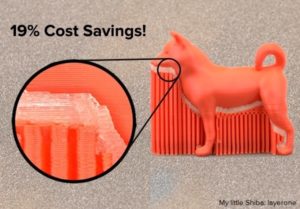Simplify3D Releases Version 4.0, Featuring User-Friendly New Features for More Options in 3D Printing
 It’s been over a year since Simplify3D released a new version of its popular 3D slicing software program. Version 3.1 offered a host of new features as well as compatibility with more than two dozen new 3D printer models, taking it a step further in becoming one of the most widely used 3D software programs. That update, however, was a small one compared to the latest update, which has now been officially released. Version 4.0, according to Simplify3D, is one of the company’s largest releases yet, and introduces a plethora of new features largely based on feedback received from the community.
It’s been over a year since Simplify3D released a new version of its popular 3D slicing software program. Version 3.1 offered a host of new features as well as compatibility with more than two dozen new 3D printer models, taking it a step further in becoming one of the most widely used 3D software programs. That update, however, was a small one compared to the latest update, which has now been officially released. Version 4.0, according to Simplify3D, is one of the company’s largest releases yet, and introduces a plethora of new features largely based on feedback received from the community.
 One of the highlights of Simplify3D Version 4.0 is the new Variable Settings Wizard, which makes it easy for users to change any setting they want for any section of their 3D model. For example, you could add extra strength or weight to one section while making another section lightweight or optimizing it for a faster printing time. It’s easier than ever to 3D print with different settings in every section of a model for a fully optimized part.
One of the highlights of Simplify3D Version 4.0 is the new Variable Settings Wizard, which makes it easy for users to change any setting they want for any section of their 3D model. For example, you could add extra strength or weight to one section while making another section lightweight or optimizing it for a faster printing time. It’s easier than ever to 3D print with different settings in every section of a model for a fully optimized part.
Also included is a new dynamic feature sizing element. Because of the fixed size of the nozzle opening on your extruder, it can be difficult to 3D print extra small, delicate or tapering features, but Simplify3D 4.0 addresses that difficulty with a new feature that dynamically adjusts the amount of material being extruded to create smaller or larger bead sizes. Now, no matter what 3D printer you’re using, you can print smaller, more detailed features than you could before, opening up new possibilities for intricate models that couldn’t previously be attained with most standard 3D printers.
Another major update is all about foundational structures – supports, rafts, and brims. Simplify3D has always been a good software when it comes to supports, but Version 4.0 now includes new features that improve the ability of support structures to stay anchored to the build platform.
Other features allow users to vary the density or material that is used for the top layers of the supports, near the part surface. So, for instance, you can switch to dissolvable support material near the surface of the print to make the supports easier to remove – and save money on often-costly dissolvable support filament.
In addition, the interactive print preview has been updated with more information about which process was used to create each part of your model. Several of the controls have been updated, including:
- Keyboard scrolling: the keyboard up and down arrows can now be used to move through lines or layers of your print
- Jump to location: new controls let you jump to an exact line or layer number to examine a specific point in time
- Position readout: the XYZ position of the toolhead is now displayed in the print preview
- Range controls: users now have the option to preview only as many lines or layers as they choose
Process transitions have also been improved to be completely seamless. A simple drag-and-drop functionality has been added to allow you to more easily order the print sequence of your parts, and sequential printing mode has been improved to allow a complete part to finish printing before the next one starts. The prime pillar and ooze shield have been updated to offer better support for multi-process prints, and a dynamic gap fill feature has been added, enabling users to automatically fill gaps or thin walls for added interior strength.
 The Dense Supports feature has been updated to allow you to choose the materials used for different sections of your support structures, and a new break-away raft design has been introduced for easier raft removal. Placement and sizing of rafts has also been optimized to ensure that they’re only used where they’re absolutely needed, saving time and materials.
The Dense Supports feature has been updated to allow you to choose the materials used for different sections of your support structures, and a new break-away raft design has been introduced for easier raft removal. Placement and sizing of rafts has also been optimized to ensure that they’re only used where they’re absolutely needed, saving time and materials.
Other updates, based on customer suggestions, include:
- Bridging perimeter options
- Bridging angle selection
- Multi-process vase mode
- External fill customization
- Improved mesh reduction
You can learn more about the new Simplify3D features – and download the latest version – here. Discuss in the Simplify3D forum at 3DPB.com.
[All images: Simplify3D]
Subscribe to Our Email Newsletter
Stay up-to-date on all the latest news from the 3D printing industry and receive information and offers from third party vendors.
Print Services
Upload your 3D Models and get them printed quickly and efficiently.
You May Also Like
AI, Robotics, and 3D Printing for Mass Customization: Dandy’s Dental Revolution
Dandy wants to do for dental labs what modern factories did for smartphones: make high-quality products, fast, at scale, without losing the custom fit patients need. In an interview with...
Creality Expands K Series With New K2 and K2 Pro 3D Printers
Creality has introduced two new models in its K series lineup, the K2 and K2 Pro, expanding on the company’s flagship range of desktop 3D printers. The launch comes a...
Chitu Systems and the FilaPartner E1: “Moisture Control for Better Prints”
Moisture may not sound like a big deal, but in FDM 3D printing, it can ruin a print. Filaments absorb water from the air, and once that moisture hits the...
Axtra3D Reports Strong Growth in First Half of 2025
Axtra3D, a company known for its high-speed Stereolithography (SLA) 3D printing technology, is seeing strong momentum in 2025. In the first half of the year, the company grew its revenue,...


































